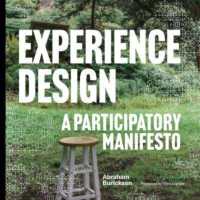- ホーム
- > 洋書
- > 英文書
- > Architecture
Full Description
You know that something is wrong, even if you can't quite put your finger on it. This book tells you why, and how to solve it.
There is a lack of beauty and emotion in our built environment. The visual patterns in nature that instinctively satisfy us are being obliterated from our surroundings, which have become progressively monolithic and featureless. We don't question why nature matters. We implicitly understand that nature feeds us metaphorically as well as literally. Nowhere was this more evident than in the lockdowns endured during the earlier stages of the Covid pandemic, where city dwellers became ever more desperate to leave the urban sprawl and get into the green. Human beings are highly attuned to the sensory inputs of the natural environment. On the large scale, we respond to the sight of a captivating view. On the small scale, our senses can come alive at the sight of richly painted flowers, the pungent green smell of freshly cut grass or the song of a blackbird.
Our response to beauty, to the right things in the right place, is part of what makes life worth living.
Over the last century, a majority of the buildings we see, work in and live in have become increasingly monolithic, functional and featureless inside and out. They are anti-nature, or put another way, anti-human. The power of architecture to inspire, move and delight has been under attack for many years and for many different reasons. But emotion in architecture matters because it satisfies and encompasses the human condition and offers a glimpse into the transcendent. Emotion in architecture allow us to appreciate, aspire and connect.
When our natural capacities for aesthetic appreciation are quashed, instead of feeling inspired, we feel imprisoned. Instead of feeling uplifted, we feel depressed. Instead of feeling liberated, we feel oppressed. Instead of feeling connected, we feel isolated. Bad buildings, like undiagnosed high blood pressure or type two diabetes, silently rob us of energy, health and well-being.
This is not about the lofty projects that academics and critics are so keen to discuss. It's about the buildings we see every day as we go about our business, the ones we live and work in: houses and shops, offices and cafes, schools and centres. It's about the fact that so many of them are letting us down.
Contents
Introduction
Welcome to the Desert of the Real
The Fantasy Architect
Too Many Cooks Spoil the Broth
The History Lesson
The White Heat of Technology
The Things We Think and Do Not Say
The Architecture of Belonging
Delight, Anyone?
Eternal
Harmonious
Unmeasurable
A Line in the Sand








